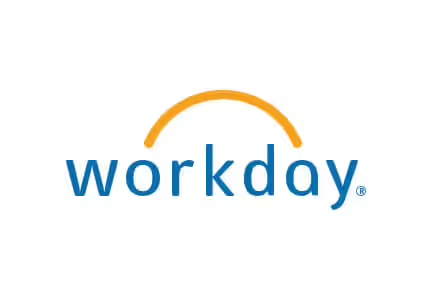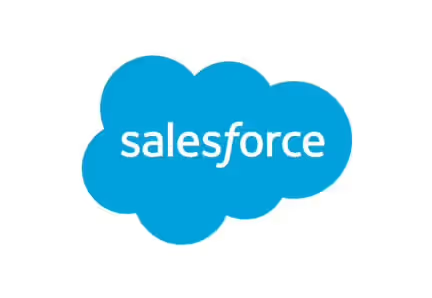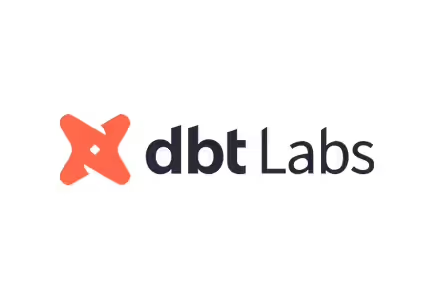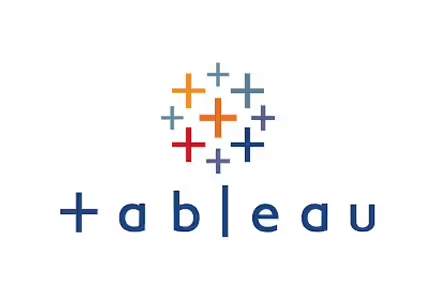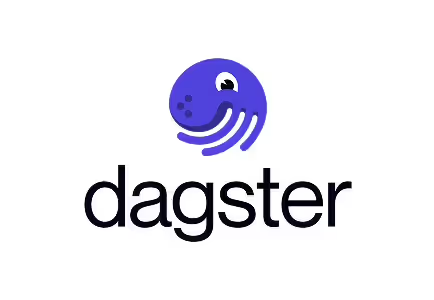Articles & case studies

What Separates a Data Laggard from a Data Leader?
The ability to leverage data effectively can be the deciding factor between business success and obsolescence. Organizations that excel in harnessing data are often referred to as "data leaders," while those that struggle with data utilization are labeled "data laggards." Understanding the distinctions between these two categories can provide valuable insights for businesses aiming to ascend the data maturity curve.
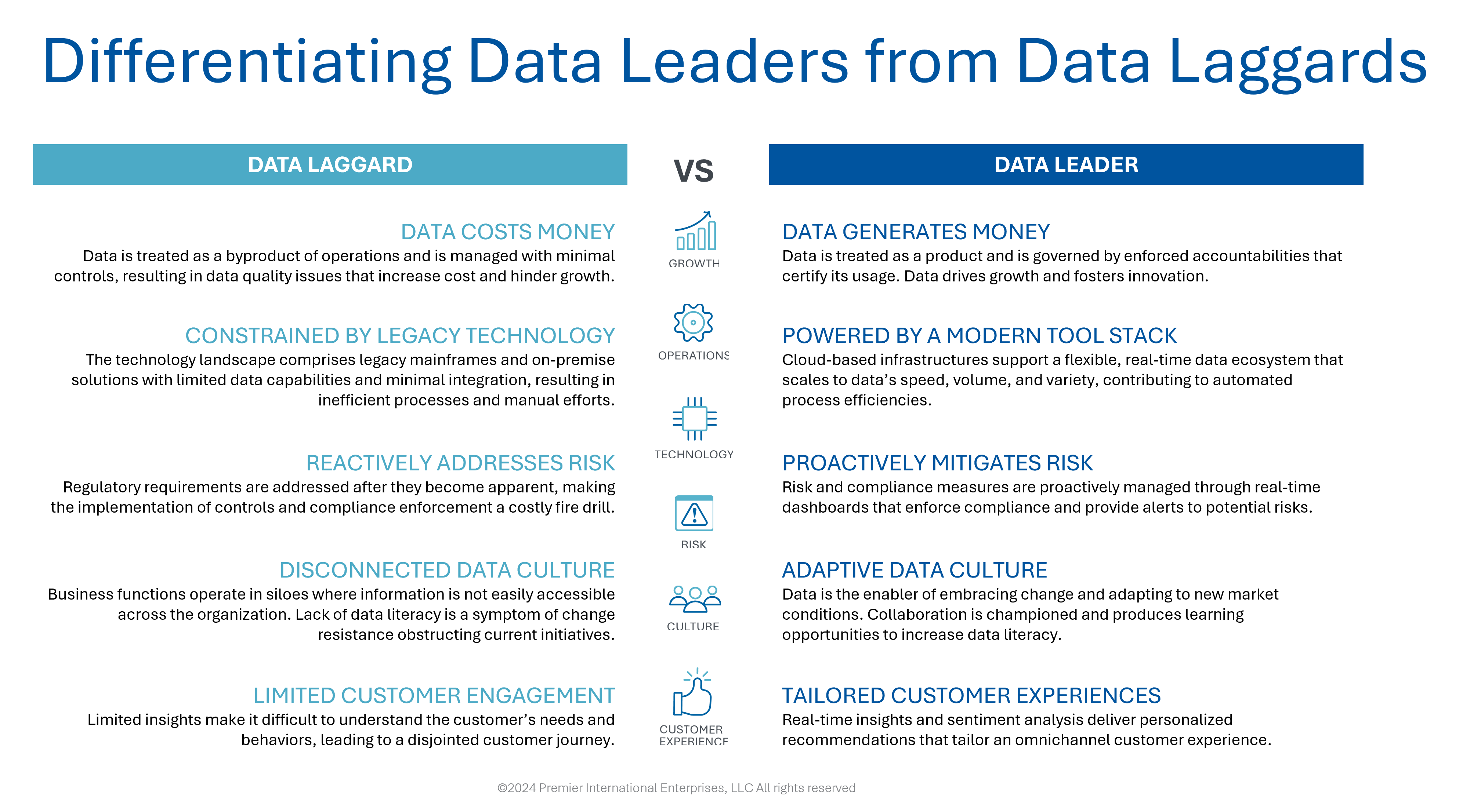
1. Data Culture: Disconnected vs. Adaptive:
Data Laggards often operate with a disconnected data culture. In these organizations, business functions are siloed, making information difficult to access across departments. This fragmentation is exacerbated by a lack of data literacy and resistance to change, which obstructs current initiatives and hampers overall efficiency.
Data Leaders, in contrast, foster an adaptive data culture. Here, data is viewed as a catalyst for embracing change and adapting to new market conditions. Collaboration is encouraged, creating learning opportunities that enhance data literacy across the organization. This culture of adaptability ensures that data is not just collected but also understood and utilized effectively.
2.Technology Infrastructure: Legacy Systems vs. Modern Data Stack
Data Laggards are often constrained by legacy technology. These organizations rely on outdated mainframes and on-premise solutions that offer limited data capabilities and minimal integration. This reliance on legacy systems results in inefficient processes and a high degree of manual effort, stifling innovation and responsiveness.
Data Leaders leverage a modern data stack. They utilize cloud-based infrastructures that support flexible, real-time data ecosystems. These systems can scale to accommodate the speed, volume, and variety of data, enabling automated processes and improving overall efficiency. This modern approach not only streamlines operations but also provides a robust foundation for future growth.
3. Risk Management: Reactive vs. Proactive
Data Laggards tend to address risk in a reactive manner. Regulatory requirements are often met only after issues arise, resulting in costly and inefficient compliance efforts. This reactive stance leaves organizations vulnerable to unforeseen risks and regulatory challenges.
Data Leaders adopt a proactive approach to risk management. They utilize real-time dashboards to enforce compliance and provide alerts to potential risks before they become critical issues. This proactive stance not only minimizes risk but also ensures that compliance measures are integrated seamlessly into daily operations, reducing costs and enhancing security.
4. Customer Engagement: Limited vs. Tailored
Data Laggards suffer from limited customer engagement. Due to insufficient insights, these organizations struggle to understand customer needs and behaviors, leading to a fragmented and disjointed customer journey. This lack of engagement can result in lower customer satisfaction and loyalty.
Data Leaders excel in creating tailored customer experiences. They use real-time insights and sentiment analysis to deliver personalized recommendations, crafting an omnichannel experience that resonates with individual customers. This tailored approach enhances customer satisfaction, loyalty, and overall business growth.
5. Data Value: Costly Byproduct vs. Growth Driver
For Data Laggards, data is often seen as a costly byproduct of operations. Managed with minimal controls, data quality issues abound, leading to increased costs and hindered growth. This perspective prevents organizations from recognizing the full potential of their data assets.
Data Leaders treat data as a valuable product. They enforce robust governance and accountability measures to ensure data quality and certify its usage. By managing data as a critical asset, these organizations drive growth and foster innovation, turning data into a powerful engine for business success.
The journey from being a data laggard to becoming a data leader requires a fundamental shift in culture, technology, risk management, customer engagement, and data valuation. Organizations that embrace these changes can unlock the full potential of their data, transforming it from a byproduct into a strategic asset that drives growth, innovation, and competitive advantage. By understanding and implementing the strategies of data leaders, businesses can position themselves at the forefront of the digital economy, ready to navigate the complexities of the modern market with agility and confidence.
Contact Definian today to engage with one of our data experts who can help you start applying data-first strategies to make the most of your information, gain a competitive edge by analyzing insights that inform decisions, and create value for your organization.
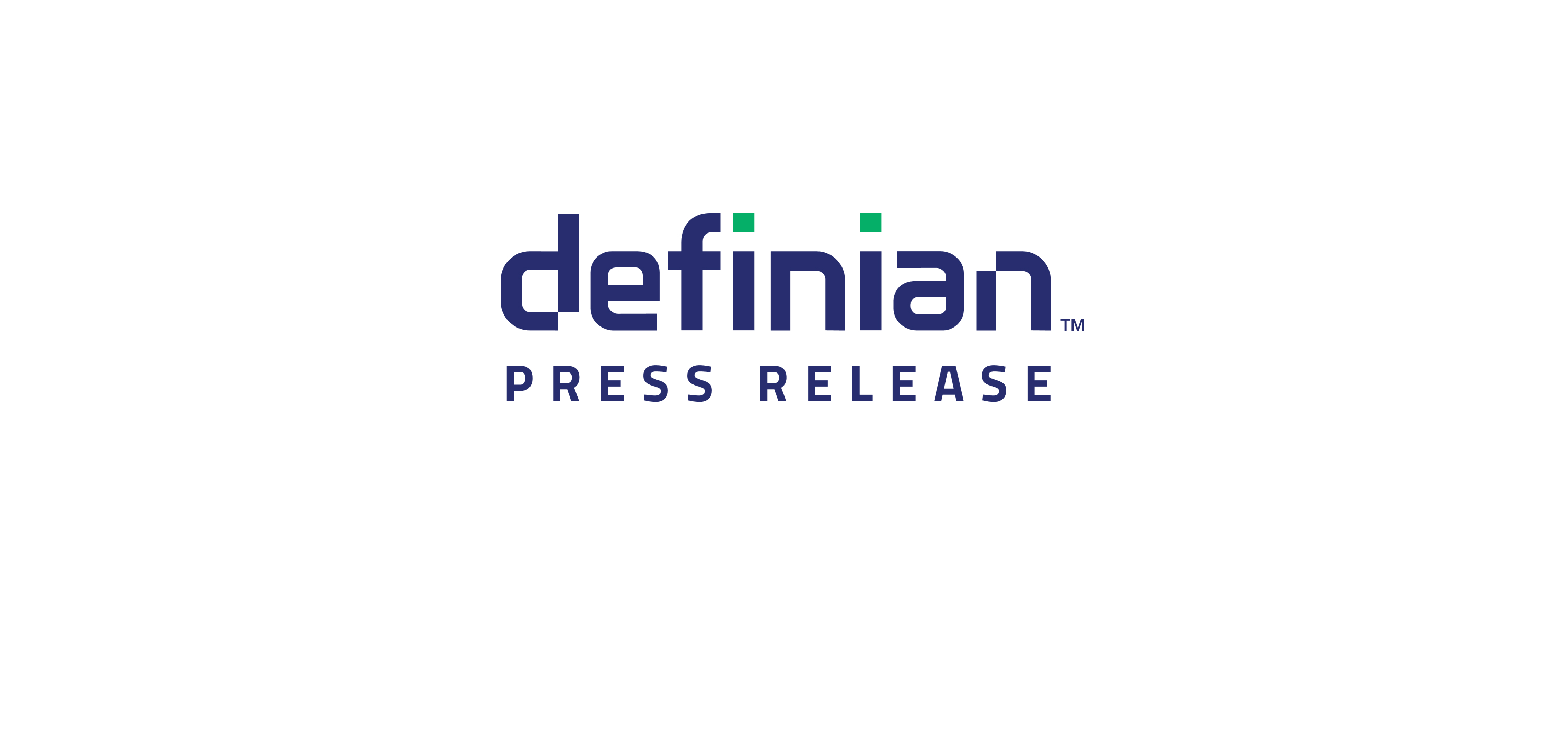
Premier International Rebrands as Definian to Help Organizations Define What’s Next in the Age of AI
FOR IMMEDIATE RELEASE
CHICAGO, August 25, 2025 – After four decades as l, the company today announced its new name and identity: Definian.
For more than 40 years, the firm has partnered with global enterprises to solve complex data challenges, from modernizing systems to advancing analytics. With its rebrand, Definian signals both continuity and change: the trusted partner organizations have relied on since 1985, now with a renewed focus on preparing leaders for the opportunities and demands of AI.
“Definian marks our evolution into an AI-enabled company,” said Craig Wood, CEO. “We’ve built on decades of experience helping organizations achieve clarity with their data, but our focus is squarely on what’s next: giving leaders the strategy, modernization, and insights they need to accelerate their AI journeys.”
The name Definian is inspired by the idea of defining what’s next. Data is no longer a back-office function; it is the foundation of every modern enterprise and the starting point for AI. Definian exists to help organizations make their data reliable, ready, and actionable, equipping leaders to move forward with confidence.
“What hasn’t changed is how we work,” said Mikel Naples, President and COO. “Our clients know us as a trusted partner who delivers measurable results. Definian is about sharpening that promise and bringing precision and purpose to every engagement so our clients can achieve outcomes that matter.”
Definian continues to build on what has always set the firm apart: four decades of experience across the data lifecycle, a proven record of results, and a partnership model that puts clients first. The company now brings those strengths into an AI era, combining deep data expertise with modern capabilities to help organizations prepare, adapt, and accelerate responsibly.
About Definian
Definian helps organizations define what’s next by unlocking the full value of their data. With expertise spanning data strategy, modernization, advanced analytics, and AI, Definian equips leaders to harness data with clarity and precision throughout their digital evolution.
Founded in 1985 as Premier International and rebranded in 2025, Definian has guided thousands of successful initiatives for global enterprises, technology providers, and system integrators. Combining four decades of data expertise with an AI-enhanced approach, Definian ensures organizations achieve measurable outcomes and sustained advantage in a world defined by data.

Understanding the Importance of Data Governance
Today, more than ever, organizations generate and rely on vast amounts of data to drive decision-making, innovation, and competitive advantage. Unfortunately, not everyone in an organization understands the importance of a formal data governance discipline and the risks associated without it. Effective data governance ensures data quality, security, and compliance, while poor data governance can lead to significant risks and increased costs. This article explores the critical role of data governance, the risks of neglecting it, and the opportunities it presents for forward-thinking organizations.
What is Data Governance?
Data governance encompasses the policies, procedures, and standards that manage the availability, usability, integrity, and security of data within an organization. Effective data governance aims to guide behaviors on how data is defined, produced, and used across the organization. It ensures that data is consistent, trustworthy, and used responsibly by:
- Establishing Data Ownership: Clearly defining who owns and is responsible for data across the organization.
- Data Quality Management: Ensuring data accuracy, completeness, and reliability.
- Data Security: Protecting data from unauthorized access and breaches.
- Compliance: Adhering to regulatory requirements and industry standards.
- Data Lifecycle Management: Managing data from creation through disposal.
The Risks of Poor Data Governance
Neglecting data governance can lead to numerous risks, including:
- Data Breaches and Security Issues: Without stringent data governance, sensitive information can be exposed to cyberattacks, resulting in data breaches. These incidents can lead to financial losses, reputational damage, and legal penalties. For example, the 2017 Equifax data breach exposed the personal data of over 147 million people, highlighting the catastrophic impact of inadequate data governance and creating a lasting impact on their brand.
- Improved Regulatory Compliance: Streamlined data governance processes eliminate redundancies and improve data accessibility, leading to greater operational efficiency. For instance, a global steel manufacturer reduced costs by hundreds of millions of dollars by streamlining its supply chain data, integrating internal and external data flows, and using the data to optimize its operations.
- Increased Operational Efficiency: Streamlined data governance processes eliminate redundancies and improve data accessibility, leading to greater operational efficiency. For instance, a global steel manufacturer reduced costs by hundreds of millions of dollars by streamlining its supply chain data, integrating internal and external data flows, and using the data to optimize its operations.
- Better Risk Management: Proactive data governance helps organizations identify and mitigate risks related to data security and integrity. This enables them to respond swiftly to potential threats and minimize their impact.
Actionable Recommendations for Implementing Data Governance
To harness the benefits of data governance, organizations should consider the following actionable steps:
- Craft a Strategic Roadmap: Identify the current data governance needs and capabilities among business and technology stakeholders to develop a business case. Establish a vision for data governance that aligns with business objectives and craft a strategic roadmap outlining key initiatives over a multi-year period. This will formalize an agile data governance function that will iteratively scale across the entire organization.
- Formalize an Operating Model: Design an operating model that aligns with the organizational culture to minimize the impacts of change when formalizing a data governance discipline. Clearly define and communicate the roles and responsibilities for members participating in the data governance program. Acknowledge data producers as contributors to defining and complying with data standards and policies. Establish a Data Governance Council to charter a formal data governance program sponsored by executive leadership.
- Compile an Inventory of Critical Information Standards and Policies: Profile data objects and break down business processes to develop a catalog of critical data elements needed for operations, analytics, financial reporting, and regulatory compliance. Rationalize each element and collaborate to establish a working definition, expected standards, and policies for how the data is created and used across the organization. Socialize the catalog outputs so that it is easily discoverable by data producers and consumers.
- Implement a Data Quality Framework: Deploy a framework that enables data quality to be measured against the standards defined in the critical information catalog. Socialize results to stakeholders and data stewards for review. Develop tactical plans to remediate exceptions and improve data quality to meet governed expectations. Monitor data quality through its lifecycle to identify opportunities from a people, process, technology, and a data perspective.
- Educate and Train Employees: Conduct regular training sessions to educate and empower employees about data governance policies, their roles, and the importance of data integrity and security. Use this as a chance to reinforce the value proposition for data governance to mitigate any change resistance.
- Continuously Monitor, Improve, and Scale: Regularly review and update your data governance policies and practices to keep up with changing business needs and regulations. Use feedback and performance metrics to continuously improve the program while measuring efficacy. Maintain a running backlog of data governance use cases and prioritize them based on their value and alignment with business goals. Scale the operating model as you work through various data governance use cases.
For senior executives and leaders overseeing data, implementing robust data governance is not just a best practice but a necessity. Effective data governance mitigates risks, ensures compliance, and unlocks significant opportunities for operational efficiency, informed decision-making, and enhanced customer trust. By prioritizing data governance, organizations can turn their data into a strategic asset, driving innovation and long-term success. By understanding and acting on these principles, executives can steer their organizations towards a future where data is not just managed but leveraged to its fullest potential.
Sources
- Equifax Breach 2017: https://www.ftc.gov/enforcement/refunds/equifax-data-breach-settlement
- Google GDPR Fine 2019: https://www.digitalguardian.com/blog/google-fined-57m-data-protection-watchdog-over-gdpr-violations
- PwC Consumer Trust Survey: https://www.pwc.com/us/en/library/trust-in-business-survey.html
- Good Data Starts with Great Governance: https://www.bcg.com/publications/2019/good-data-starts-with-great-governance
- The Impact of Data Governance: https://www.techtimes.com/articles/304151/20230121/the-impact-of-data-governance-in-multi-cloud-environments-ensuring-security-compliance-and-efficiency.htm
- Risk Management and Data Governance: https://www.microsoft.com/en-us/security/business/security-101/what-is-data-governance-for-enterprise

Overcoming the Hurdles: Getting past the blockers CDOs face to operationalize Data Governance
In today’s vast information landscape, a Chief Data Officer’s (CDO) role is critical for unlocking an organization's data potential. Despite their strategic importance, CDOs face unexpected challenges that hinder their ability to deliver tangible business value, leading to an average tenure of less than a couple of years. In this article, we explore four key areas that impede a CDOs' progress and methods that can help build momentum in achieving data governance objectives.

Investment Uncertainty
Data governance initiatives require investments in resources, technology, and personnel. However, securing buy-in and funding from stakeholders can be daunting, especially when the return on investment (ROI) is not immediately apparent. CDOs must navigate the complexities of justifying the long-term benefits of data governance, which may not yield immediate financial gains. This investment uncertainty can lead to hesitation and resistance from decision-makers, hindering CDOs ability to execute their strategy.
To mitigate these challenges, CDOs must proactively communicate the strategic value of data governance and its potential to drive operational efficiencies, risk mitigation, and competitive advantages. A simple method CDOs can use to quantify value is to assess long-term impacts through the lens of the cost of doing nothing. They should also prioritize high-impact, low-cost initiatives and seek to align data governance efforts with the organization's immediate business objectives, delivering quick wins that provide incremental business value.
People Gaps
Effective data governance relies heavily on the expertise and collaboration of cross-functional teams. However, organizations often face a shortage of skilled data professionals, including data analysts, data engineers, and data stewards. These gaps are often filled by assigning existing resources with additional responsibilities they do not have the time or skills to successfully fulfill. This is further compounded by change resistance, which hinders the CDOs ability to build a data culture. This people gap can create bottlenecks in the implementation of data governance initiatives as CDOs struggle to find the right talent to drive their vision forward.
To address the people gaps, CDOs must build a strong data culture, provide comprehensive training and awareness programs, establish clear roles and responsibilities, and foster cross-functional collaboration. Additionally, they should work closely with their Human Resources department to attract and retain top data talent and engage with executive leadership to secure buy-in and support for data governance initiatives.
Time-Sensitive Initiatives
In a fast-paced business environment, CDOs are often responsible for executing urgent projects that demand immediate attention. However, these time-sensitive initiatives can create conflicts in prioritization, leading to a diversion of resources and focus from long-term data governance initiatives. As a result, operationalizing data governance will lack consistency and continuity.
CDOs must effectively balance addressing short-term demands with maintaining a strong commitment to their overarching data governance roadmap, which is no easy task. Rushing through the implementation of data governance can lead to oversights and errors, resulting in technical debt, data quality issues, and increased complexity in maintaining a unified data governance framework.
To overcome these challenges, CDOs must proactively communicate the strategic value of data governance and its long-term benefits to the Business. They should collaborate closely with business leaders to align time-sensitive initiatives with data governance objectives. By prioritizing business needs with the data governance roadmap, the CDO can ensure the right capabilities are being developed to generate business value incrementally with data governance.
Inability to Demonstrate Value
One of the key challenges that CDOs face is the difficulty in effectively communicating and demonstrating the tangible value of data governance initiatives to stakeholders. Data governance is often seen as an abstract concept, making it hard to quantify its impact on business outcomes.
CDOs must create compelling narratives and metrics that resonate with decision-makers, demonstrating how data governance can enhance operational efficiencies, reduce risks, and generate new revenue streams. Failing to articulate this value proposition may result in a lack of support and buy-in from key stakeholders. Without this buy-in, obtaining the necessary resources, budget, and organizational commitment to implement and sustain data governance initiatives becomes challenging. If data governance efforts are not seen as providing tangible benefits, the CDOs role and authority may be weakened, hindering their ability to deliver their data governance strategy.
To address this, CDOs should proactively communicate the strategic value of data governance through clear metrics, success stories, and quantifiable business outcomes. When data governance performs well, organizations should experience improved data quality and optimized business processes. Socializing these results is essential to demonstrating the value and outcomes realized with the investment in data governance. By tackling these challenges directly, CDOs can position themselves as strategic leaders, driving a data-driven transformation and unlocking the full potential of their organization's data assets.
At Definian, we assist our partners in understanding the fundamental importance of implementing data governance and emphasize the value proposition by educating leaders about the impacts of inaction. CDOs can tackle these common blockers by employing an agile, multi-faceted approach that aligns data governance initiatives with business objectives and secures the required sponsorship and support from the top down while establishing stewardship accountabilities from the bottom up. By empowering CDOs to overcome these challenges, they can showcase the value of data governance and drive sustainable progress within their organizations. Our objective is to ensure that data governance initiatives receive the necessary sponsorship, support, and resources to unlock the full potential of data as a strategic asset.

Navigating Compliance and Talent Management Through Effective HCM Data Governance
For a 30,000-employee industrials company growing rapidly through acquisitions, maintaining accurate HR data was a constant challenge. Each new acquisition brought an influx of disparate data, inconsistent structures, and compliance risks, particularly when meeting federal reporting requirements like Affirmative Action Plans (AAP), Equal Employment Opportunity (EEO), and Fair Labor Standards Act (FLSA) regulations. These gaps in HCM data fundamentals not only strained resources but also delayed strategic decision-making about talent across the organization.
When the company engaged us, their HR team faced a tangled web of challenges. Data preparation for newly acquired companies took up to six weeks, consuming hours of manual effort. Inconsistent job classifications, mismatched AAP codes, and errors in hierarchical reporting were just a few of the recurring issues. Over the course of our partnership, we implemented a series of targeted interventions to clean up their data, automate quality checks, and establish sustainable HCM data governance processes that transformed their HR function.
Diagnosing and Resolving Systemic HR Data Errors
The first step in addressing the company’s HR data issues was to thoroughly diagnose the root causes of their errors. Our diagnostics uncovered a range of problems, from blank or missing fields to misaligned reporting structures. For instance, many employee records were missing critical information, such as job or position data, making it nearly impossible to maintain compliance with federal reporting requirements. These gaps highlighted the need for better HCM data best practices around record-keeping and validation.
We also encountered complex issues related to hierarchical relationships within the data. In some cases, managers and subordinates were incorrectly assigned, creating circular reporting structures that led to confusion and undermined organizational clarity. Other inconsistencies included discrepancies between positions and their corresponding job records, as well as mismatches between organizational units assigned to employees and their roles.
To resolve these challenges, we implemented:
- Rigorous data validation processes that flagged errors and inconsistencies.
- Systematic cleanup of reporting structures, ensuring clarity and alignment.
- Enhanced reporting templates that captured the necessary data fields to meet compliance requirements.
These efforts not only reduced immediate errors but also laid the groundwork for more robust HCM data governance practices moving forward.
Establishing Standardized Validation and Configuration
After addressing the initial wave of data errors, we shifted our focus to preventing future inconsistencies. Standardizing HR data configurations across the parent company and its acquired entities was essential. Disparate systems and manual processes in the acquired companies frequently led to issues such as mismatches between Affirmative Action Plan (AAP) codes and Equal Employment Opportunity (EEO) categories. Similarly, pay scales and personnel subgroups were often misaligned, leading to significant compliance risks and reporting inaccuracies.
We developed standardized templates and automated validation rules that ensured alignment across all entities. For example, we predefined valid combinations of AAP and EEO codes, allowing the system to flag invalid entries before they propagated. We also implemented rules to align job classifications with pay scales, addressing common issues where managerial roles were not correctly tied to corresponding compensation structures.
By creating and deploying these templates and rules, we gave the HR team tools to validate data at the point of entry. This significantly reduced the volume of errors and manual corrections, enabling the team to focus on more strategic tasks. These efforts reinforced the importance of HCM data best practices in ensuring consistent and reliable data.
Automating Data Audits and Reporting
Data quality is not a one-time fix; it requires continuous monitoring. Recognizing this, we partnered with the HR team to automate their data quality audits. Previously, audits were conducted sporadically and often relied on labor-intensive processes. We introduced automated tools created in Applaud to generate monthly diagnostics, a cornerstone of effective HCM data governance.
These automated reports provided a clear picture of data health across the organization. For example, they identified discrepancies where employees’ organizational units did not align with their assigned positions, or where Fair Labor Standards Act (FLSA) classifications were mismatched. By detecting these errors close to real time, the HR team could address them proactively.
We also tailored the reports to meet the needs of different stakeholders, offering division-level breakdowns as well as consolidated organizational summaries. This allowed the company to prioritize corrections efficiently and maintain high levels of data integrity while adhering to HCM data best practices.
Building a Scalable Data Governance Framework
To ensure long-term success, we worked with the company to establish a robust HCM data governance framework. This involved defining clear ownership of HR data fields and creating processes for maintaining data accuracy. We documented standard operating procedures for data validation, error escalation, and corrective actions, ensuring that the HR team could sustain high data quality even as the organization continued to grow.
An integral part of this effort was updating training materials for HR administrators. These materials covered everything from field definitions and job classification standards to the proper configuration of manager assignments. By empowering the HR team with the knowledge and tools they needed, we helped build a culture of accountability and precision—essential for maintaining HCM data fundamentals across a rapidly expanding organization.
Optimizing Processes for Acquired Companies
One of the most significant outcomes of our engagement was the transformation of the data onboarding process for newly acquired companies. Previously, it could take up to six weeks to prepare and integrate HR data from a new acquisition—a process fraught with errors and inefficiencies. By adding field derivations, automated validity checks, and simplified handoffs, we reduced this timeline to just one week of part-time effort.
This optimization not only accelerated integrations but also ensured that acquired companies were aligned with the parent company’s standards from day one. Pre-configured templates and automated validation reduced the burden on both the parent company and the acquired entities, creating a seamless transition. These efforts showcased the practical application of HCM data best practices in real-world scenarios.
The Business Impact: From Chaos to Confidence
By the end of our engagement, the company’s HR function had undergone a dramatic transformation. Key outcomes included:
- Regulatory Compliance: The company achieved consistent compliance with federal AAP, EEO, and FLSA requirements, significantly reducing regulatory risks.
- Enhanced Data Quality: Automated diagnostics and continuous monitoring ensured that errors were caught and corrected before they could impact reporting or decision-making.
- Operational Efficiency: Manual data preparation efforts were reduced by 80%, freeing up valuable time for the HR team to focus on strategic initiatives.
- Scalable Processes: A robust HCM data governance framework positioned the company to manage HR data effectively across future acquisitions.
This transformation highlights the power of mastering HCM data fundamentals. Through strategic interventions in HCM data governance, quality, and migration, we helped this company turn its HR data challenges into strengths, providing a solid foundation for compliance and talent management. As a result, they are now better equipped to understand and leverage their workforce, ensuring their continued growth and success.
By emphasizing HCM data best practices, robust HCM data governance, and the essentials of HCM data fundamentals, organizations can build sustainable frameworks that not only meet compliance standards but also enable strategic workforce management. Let this story inspire your journey to smarter, more reliable HR data.

Equipping a Workday Implementation with Data Governance
Background
Our client, one of the largest US ports, was preparing for a vital multi-year ERP transformation journey with Workday at its core. Acknowledging the pivotal role of data and recognizing gaps in their existing data management capabilities, the CIO sought to ground this transformation initiative with a formal data governance function – imperative for aligning business objectives with data requirements and enabling the adoption of Workday through data fidelity and trust.
Choosing Definian
Definian stood out with a unique value proposition that demonstrated expertise not only in understanding the intricate data requirements of a Workday implementation but also in presenting a strategic vision for data enablement that will drive implementation efforts to success. This included foundational data management disciplines for data governance and data quality to not only support the ERP go-live but also are required to maintain data integrity in the future. This, coupled with a proven track record in navigating organizations through complex data transformation initiatives, instilled confidence in Port leadership, affirming our suitability as the ideal partner.
The Process
Definian delivered a multi-phased tactical plan to develop and execute a strategy to formalize a data governance discipline at the Port. The approach tailored and launched a data governance framework aligned with the business operating model. Recognizing that data governance was a novel concept at the Port, an educational component was incorporated to facilitate change adoption and operationalize data governance concepts into an ongoing data management discipline. This was accomplished by working through use cases with the council centered on four targeted end-to-end business processes. Following the launch, Definian transitioned data governance facilitation to the Port’s appointed data governance leader and provided them guidance to sustain the momentum required to operationalize the council.
The objectives of each phase were:
Phase 1: Strategic Assessment
· Obtain a current state understanding through stake holder engagement
· Envision a desired state for data governance tailored to the Port’s operating model
· Translate gaps into prioritized capability-building initiatives
· Define a strategic roadmap of initiatives to implement data governance
Phase 2: Data Governance Launch
· Charter the launch of an Interim Data Governance Council
· Educate concepts for data governance and data quality frameworks
· Develop data governance rigor by working through targeted use cases
Phase 3: Operationalize Data Governance
· Sustain data governance momentum from the initial launch
· Transition facilitation to the Port’s data governance leader
· Compile formal data governance standards and policies for critical information
Results
By delivering on this initiative in less than six months, the outcomes have been promising as the Port approached its Workday implementation.
- Provided a shared understanding of the Port’s current data management capabilities and desired vision for data governance
- Launched a centralized data governance operating model comprising data owners and subject matter experts that’s Business-driven and IT-supported
- Established a cross-functional Data Governance Council promoting collaboration in formalizing data requirements, standards, and policies across the Port’s applications, processes, and reports
- Educated data governance and data quality concepts into practice through the execution of targeted use cases that generated data governance artifacts
- Achieved consensus with an initial inventory of critical data elements and their supporting definitions, standards, and stewardship accountabilities, providing clarity and eliminating redundant efforts from future Workday data migration and requirements tasks
In conclusion, through strategic implementation of data governance, our client not only embraced the intrinsic value of their data but also secured a resilient foundation for their Workday transformation, ensuring a more rapid and cohesive transition tailored to their long-term goals.

Developing a Data Strategy and Data Observability Capabilities to Address Data Risk factors for a Leading Airline
Background
After resolving an unauthorized data incident that was reported on the nightly news, our Client, the CISO of an airline, needed to prevent future breaches by getting their arms around data risk across the enterprise.
To identify PII and confidential data distributed across many sources in a dynamic data landscape, the airline needed to understand where those critical and sensitive data assets reside and develop capabilities that identify and monitor data access gaps as they arise.
Four objectives needed to be met to complete this initiative.
- Catalog sensitive data across structured and unstructured data throughout the organization.
- Identify and resolve any gaps within the data access controls within Azure.
- Create a process that constantly monitors data risk and pushes out alerts when a critical gap is detected.
- Create an observability portal that shows an at-a-glance data risk score, the current gaps, the severity of each gap, and a mechanism for correcting each gap.
Why Definian
Our Client chose Definian as their partner for this sensitive work because of our expertise in data strategy for major financial institutions and our deep technical knowledge in building underlying connectors for leading data platforms.
The Work
To meet the first objective, BigID was deployed to scan, discover, and catalog the sensitive data. BigID is the leading product in automated data discovery and classification and was the standout choice for uncovering and monitoring unstructured and structured data throughout the organization.
With the sensitive data catalog in hand, we reviewed the access controls within Azure and immediately began to address any data sensitivity access gaps. As we resolved the gaps in the technical controls, we worked with our Client to address the data governance processes that led to the gaps.
With the current gaps resolved, we developed a process that would provide a proactive backstop to address future issues. There are two components to the backdrop. For the first component, Definian integrated Azure data access controls and BigID's ongoing scan results. This integration connects and analyzes the metadata from each solution and pushes out real-time alerts when a critical gap is detected. The second component was to utilize the integration to power a risk observability portal.
The risk observability portal enabled an at-a-glance assessment of the current data risk levels across the organization. The observability portal has two main features. The first is a risk score calculated by analyzing the various types and numbers of gaps. This score instantly communicates current risk levels and trends. The second feature displays the details behind the gaps and a mechanism to correct them within that single screen.
Results
With this additional observability capability, our Client is confident in always knowing their overall risk exposure. They now have a comprehensive process that tracks the unstructured and structured data across their dynamic landscape and a mechanism for quickly addressing gaps.

Data Governance and Data Quality Program for Retail Holding Company
Background
A rapidly growing Dubai-based retail-oriented holding company faced increased data regulations as it expanded its business interests in the Middle East region. It needed to establish a more robust and proactive Data Governance, Quality, and Privacy program to accelerate compliance with these increased data regulations.
The main objective of this initiative was to establish a Data program across 15 Operating companies with business interests in over 20 countries.
The Challenge
Beyond the organizational complexity of coordinating across the 15 Operating companies, our Client faced a rapidly evolving regulatory landscape around consumer data and privacy. Each operating company had a low data quality maturity that limited the ability to control and prevent known compliance issues. Lastly, the organization needed an in-house capability to set up and operate a complex program and gain support.
Why Definian
Our Client selected Definian to partner with on this initiative because of our experience building and facilitating complex data governance and quality programs. That expertise provided the confidence that Definian could build a flexible, democratized program to keep the organization ahead of their regulation requirements.
Primary Deliverable
As we engaged with our Client, we assessed current maturity levels and cataloged the data governance, privacy, and security requirements. Using the assessment results, we built a hub-and-spoke Data Governance model supporting all business units. This model enabled each business unit to operate independently while meeting common standards established at each hub.
As part of the data governance program's setup, we guided our Client through a data governance and quality platform selection process. Together, we evaluated several alternatives to ensure that the platform aligned with the Client's evolving needs and future vision. Using the platform, Definian connected, scanned, and collected metadata for 109 systems. Through those scans and data governance operations, 600 Critical Data Elements were identified.
With the governance operations and platform operational, the project's next step was to address the significant data quality issues. With limited Client resources, our Client turned to Definian to set up and operate a Data Quality as a Service program. Combining automated tools and Definian's consulting team, we quickly started the data quality improvement process while collaborating on formal organization-specific requirements. Additionally, we rolled out DQ dashboards tailored for each operating company.
Next steps
While much work remains, the organization has significantly increased its data maturity. It's equipped to more readily do business in more countries and adapt to changing regulations. Our Client now also has the data confidence to take advantage of more advanced ML/AI capabilities, which will accelerate their organizational growth.

Premier International(Now Definian) Shines in Built In Awards 2024
We’ve got some amazing news to share. 🎉 Premier International(Now Definian) has been recognized by Built In, who just announced their 2024 Best Places to Work Awards! And guess what? We didn’t just make the list once—we’ve been recognized in multiple categories, showcasing our commitment to fostering an exceptional work environment and employee-centric culture.
The company has secured coveted positions in the following Built In Awards:
- Chicago's Best Midsize Places to Work (#5)
- Chicago's Best Places to Work (#14)
- US Best Midsize Places to Work (#31)
- US Best Places to Work (#59)
This is truly a testament to the incredible values-driven environment we’ve built together—a place where everyone feels valued, supported, and excited to come to work every day.
What got us here? Well, Built In’s criteria isn’t just about the perks (though our snack game is pretty strong). They look at everything—from how we compensate and support our team to the flexibility we offer and our commitment to diversity, equity, and inclusion.
Built In determines the winners of Best Places to Work based on an algorithm, using company data about compensation and benefits. To reflect the benefits candidates are searching for more frequently on Built In, the program also weighs criteria like remote and flexible work opportunities, programs for DEI and other people-first cultural offerings.
We believe that by attracting and retaining top talent, we are in the best position to serve the clients who rely on us to help with their mission critical data requirements. We are so proud of Built In’s validation of what we have created.
We are always looking for top talent to join our team, if you’re interested in exploring our current openings, please visit our careers page.

Workday Human Capital Management Data Migration for a $3.5B Healthcare System
A $3.5B healthcare provider moved their HCM and payroll operations from 15 disparate legacy applications to a single Workday tenant. Premier facilitated the data migration for this initiative. Download the PDF to learn how Premier made the data track successful.
Project Scope
- 15 Legacy Applications
- 50 Conversion Objects
- 20K Employees
- 18 Months
Key Data Objects
Core HCM | Compensation | Payroll | Absences | Benefits | Talent | Recruiting | Learning
Primary Data Sources
Infinium | Sage HRMS | Meditech | JobVite | Healthcare Position | Manager | MyCompass | Healthstream | Relias | Lippincott | Elsevier | ADP | Fidelity | Active Directory | Reliance Matrix
Expectations
- On-Time and Budget
- Drive Data Quality
- Minimize Client Resource Effort
- No Impact on the Open Enrollment Process
Risk Factors
- Client Resource Constraints: Client resourcing was limited and often times a single person was responsible for many tasks spread across multiple workstreams. Premier needed to enable our client to spend time focusing on items that only they could answer and clear other data obstacles from their path.
- Duplication Across Legacy Systems: Each legacy system used a worker-based approach in how they managed worker data, with three positions under the same worker as three separate workers with different employee IDs. Additionally, the legacy infrastructure prevented the business from getting insights of harmonization issues across the various data sources.
- Inconsistent Legacy Data Files: When the legacy data was managed by third-party vendors or the legacy infrastructure prevented direct access, data extracts were generated as part of the migration. Getting consistent/accurate extracts from these systems was difficult and needed processes in place that helped ensure their accuracy.
- Last Minute Changes to Scope: Change is expected in large implementations. The client understood the risk of scope change and expected the data team to address any scope change in stride. The most impactful scope change was that benefit providers switched during the final build. This required new data sources to be incorporated and tested without impacting the timeline.
- Benefits Open Enrollment: During the last two months of the implementation, the organization went through open enrollment with a new benefits provider. Premier needed to enable the client to focus on facilitating open enrollment while incorporating all the necessary changes needed to the data migration without impacting timelines.
- Complex Cutover Transaction Maintenance: High volumes of transaction data needed to be migrated, monitored, and managed during the cutover window. To ensure the accuracy of migrations and to not disrupt business, validation needed to be efficient and trustworthy.
Premier's Workday Accelerator's
- Shortened Tenant-Build Timelines: Hundreds of Workday pre-validations dynamically check converted data against tenant configuration before load; speeding up issue identification, issue resolution, and overall load time allowing more time for users to test.
- Real Data, Real Quick: With Premier, clients achieve data-load success percentages over 90% in the first (Foundation) tenant build, fueling more accurate Workday tenant configuration and test results during the subsequent project stages.
- Workday Delivery Approach: Step-by-step data conversion execution process from the Plan stage through the Deploy and Hypercare stages, understanding the dependencies and ensuring all execution follows the Workday delivery approach.
- Tenant Upgrade Support: Data conversion tool assessment with each semi-annual tenant version release to ensure conversion solution always meets the current requirements.
- Templated Workday Conversion Tools: Developed with years of Workday implementation experience, our tools expedite requirement gathering and conversion development while ensuring you get the best solution.
- Customized Data-Quality Strategy: Insight into the legacy data landscape, alongside the understanding of Workday best practices, allows Premier to deliver a customized data-quality strategy suited to your specific needs.
- Automated Cleansing: Automatically cleanse data objects such as Employees, Addresses, Students, or Suppliers, ensuring that your Workday solution goes live with data quality standards fit for the cloud.
- Your Data, Workday-Ready: Generate load-ready data in standard Workday Advanced Load, Enterprise Interface Builder (EIB), iLoad, and any other custom load workbooks.
- Data Validation Support: Accelerate the validation process through post-conversion validation planning and reports for functions such as payroll or finance.
Mitigating the Risk - Client Resource Constraints
- Gated activities within project management strategy to keep the team focused on most critical tasks
- Leveraged Applaud data profiling capabilities to accelerate data mapping activities
- Accountable for data extraction, profiling, analysis, cleansing, and transformation data conversion activities enabling client resources to focus on requirements, validation, and getting familiar with Workday
- Applaud's data cleansing and enrichment features enabled the business to focus on what correct looks like and let the actual data cleansing occur in within Applaud's data repository
Mitigating the Risk - Duplication Across Legacy Data Sources
- Leveraged Applaud's data matching engine to automate the legacy data linkage and deduplication of employee and contingent workers
- Automated the process to select the correct primary position by applying a custom set of rules to Applaud's data-matching engine
- Improved the business's vision of overlapping data across the legacy data sources through Applaud's reporting capabilities
- Implemented a detailed audit approval process that provided a clear view of all the deduplication and consolidation that occurred during the migration
- Broke down the silos between multiple entities through the establishment of clear data ownership, stewardship, and governance processes to promote trust and increase the accuracy of all cleansings, enrichments, and transformations
- Managed a new position-based system through the implementation of complex eligibility checks and provided the analysis to give the business clarity and trust that the plans were assigned appropriately to the correct position
Mitigating the Risk - Inconsistent Legacy Data Files
- Identified file structure changes with the third party provided data files using Applaud's import reporting process
- Established file review process with third-party system administrators to confirm unexpected changes that occurred before each tenant build
- Created detailed workflows that ensured alignment between the business, third-parties, and data conversion team
- Documented the complex data extraction process to show where, when, who, and how all data is extracting from legacy environments
Mitigating the Risk - Last Minute Changes to Scope
- Executed data track risk management process that pinpointed scope risks months ahead of the go-live period to allow adequate time to mitigate most changes
- Kept last-minute specification changes in line by enforcing Premier's specification freeze portion of our process that requires extra approvals when changes come in after agreed-upon dates
- Quickly identified the impact of requested specification changes through Applaud's "Where Used" and "Functional Snapshot" features
- Collaborated with the implementation partner to identify the most efficient way to incorporate critical scope changes that occurred mid-build into the load schedule without impacting timelines
- Implemented scope changes into the automated migration programs without impacting deadlines through Applaud's transformation components
Mitigating the Risk - Benefits Open Enrollment
- Proactively strategized with the benefits team to change the conversion approach to accommodate open enrollment administration and the incorporation of new benefits provider data into the implementation
- Leveraged Applaud's rapid application development capabilities to implement conversions necessary for the new benefits provider within the project timeline
- Facilitated additional test cycles to flush out issues ahead of the gold build window
Mitigating the Risk - Complex Cutover Transaction Maintenance
- Enabled the team to address missing configurations in the tenant ahead of the cutover window through Applaud's Workday pre-validations
- Instilled confidence in the transactional data through Applaud's Workday pre-validation reports that alert the team of data issues within the EiBs and DGWs
- Optimized transaction conversion schedule by identifying and proving out that certain data files be loaded prior to and after cutover
- Facilitated the migration process through a repeatable, predictable, and highly automated migration process within Applaud
- Accelerated the validation and reconciliation process by providing validation reports that join the legacy data to the fully migrated data from Workday.
- Provided 24 hour support during throughout the cutover period in case of any unexpected surprises (there weren't any)
Project Results
- 100% load success for Core HCM
- Migrated 19,794 employees and 3,579 contingent workers with 100% load success
- Identified and closed 1,179 of 1,192 data related defects
- Harmonized data for 1,173 duplicated employees
- 97% load success across all data objects for the Configure and Prototype build
- Data conversion completed on time and within budget
- Expectations for limiting internal resource time was exceeded

Reducing Integration and Analytics Costs for a Fortune 500 Cloud Solutions Provider
Background
A Fortune 500 CRM (Customer Relationship Management) and cloud solutions provider faced the complex challenge of exponential growth in integration, compute, and data warehousing costs caused by the rapid acceleration of data volumes across its data landscape. The organization needed to move its data and analytics from Snowflake to a custom-built Hive solution on the Amazon AWS (Amazon Web Services) platform to reduce costs and improve performance.
Why Definian
While the Client has significant in-house data analytics and cloud infrastructure skills, they needed data engineering expertise to complete this initiative in the desired time-frame. The client had previously worked with Definian on data governance and integration projects, and through that experience, knew Definian had the necessary skills, accelerators, and methods to carry out this project efficiently and effectively. This was validated by Definian's three decades of experience building complex data engineering solutions.
The Project: A Joint Effort Across Four Milestones
Like many large transformative initiatives, this project simultaneously posed significant risk and value. To reduce project risk and maximize value along the way, the initiative was split into four distinct milestones. This modular approach enabled the Client to realize value throughout the initiative without disrupting current processes. It also enabled the Client and Definian to focus their energy on their respective strengths.
Being a pioneer in cloud applications and data modeling, the Client owned the design and development of the new analytics platform. The Client leveraged Definian’s data engineering solutions to minimize development time and maximize data pipeline throughput. While Definian upgraded the data pipelines that fed their analytics platforms, the Client focused on data models and cloud architectures.
Milestone 1: Migrate Jitterbit Integrations to AWS Glue
The project's first milestone focused on replacing approximately 300 Jitterbit integrations that connected the Client's operational data to their primary analytics data stores in Snowflake and Redshift. To help keep this milestone on track, Definian used its integration design frameworks and reference library to reverse engineer the poorly documented legacy Jitterbit integrations and replicate them in AWS glue.
Milestone 2: Design and Build the Pipelines for the Future State Data and Analytics Platform
While the Client focused on designing and developing the Hive database in AWS infrastructure,Definian designed and built the future state integration framework and process. Collaborating closely with the Client, Definian enhanced the integrations from Milestone 1 to easily re-point to the new analytics warehouse during cut-over. Additionally, Definian and the Client found opportunities to rationalize and improve the performance of existing integrations. As part of the improvements, Definian increased pipeline efficiency by transitioning/mirroring the ETLs from AWS Glue to Apache Airflow.
Milestone 3: Migrate from Snowflake to Hive
With the new analytics platform operational, it was time to migrate the data and shut down Snowflake. Definian built a Snowflake to Hive pipeline to execute the migration using PySpark in Apache Airflow. This approach maximized throughput and minimized development time. To reduce downtime during the cut-over, Definian and the Client collaborated on a tight cut-over plan. The execution of the plan exceeded expectations, resulting in no downtime and an on-time go-live.
Phase 4: Consolidate Data Silos
After the new analytics platform went live, the last step was consolidating and decommissioning additional data silos into the new analytics platform. Definian designed the pipelines and processes for this last step to enable the Client to self-execute the plan when ready. When the Client was ready to migrate, Definian provided as-needed back-up to the Client.
Impact: Improved Data Pipelines, Improved Data Analytics, Lower Costs
This complex initiative enabled long-term sustainable analytics capabilities for the Client. They have a pathway for more intelligent AI, sharper analytics, and data-driven decisions. The new data pipelines in Apache Airflow run at a lower cost and greater efficiency than the prior Jitterbit framework.

Building the Data Integration Capabilities for Leading Data Privacy Platform
Introduction
A quickly growing data security, privacy, compliance, and governance software provider found itself facing a significant hurdle: their cutting-edge data discovery algorithm couldn't easily work with the systems their customers already used. To keep growing and attracting new clients, they needed a swift solution to improve how their software could integrate with a variety of other metadata management technologies.
Choosing Definian for the Solution
The reason they turned to Defnian was clear: Definian had a strong track record of engineering seamless integrations for Fortune 500 organizations and other leading data platform solutions. With three decades of expertise in making legacy and modern technologies work together, Definian was the standout partner for this initiative.
Setting Project Goals
The goal for this initiative was twofold. The project's main aim was to create bi-directional integrations with Alation and Informatica EDC. These two initial integrations would enable the Client’s data discovery algorithm to create a unified data catalog that includes sensitive and PII information in common customer environments. The secondary aspect of the project would set the foundation for rapidly incorporating additional integrations into the core product, enabling the Client’s data engineering team to continue focusing on improving their core product's data discovery capabilities.
Outcome: A Game Changer
Since the initial engagement, the partnership has continued to expand the product’s integration capabilities to accelerate the implementation process and serve their customer’s increasingly complex data privacy, security, and governance requirements. The results helped propel this prominence in the marketplace:
- It earned a spot as Gartner Magic Quadrant leader.
- Household names like American Airlines, Discover, and Dell came on board as clients, drawn by how well the software could connect with tools they already use.
- Foundation is set to enable exponential increase in integration capabilities through a soon-to-be-released marketplace.

